Artificial insemination
From Wikipedia, the free encyclopedia
"IUI" redirects here. For other uses, see IUI (disambiguation).
| Artificial insemination | |
|---|---|
| Intervention | |
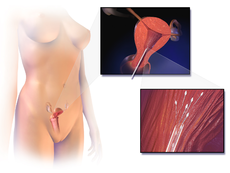
Schematic illustration of artificial insemination
| |
| ICD-9-CM | 69.92 |
| MeSH | D007315 |
Artificial insemination (AI) is the deliberate introduction of sperm into a female's uterus or cervix for the purpose of achieving apregnancy through in vivo fertilization by means other than sexual intercourse. It is a fertility treatment for humans, and is a common practice in animal breeding, including dairy cattle (see Frozen bovine semen) and pigs.
Artificial insemination may employ assisted reproductive technology, sperm donation and animal husbandry techniques. Artificial insemination techniques available include intracervical insemination and intrauterine insemination. The primary beneficiaries of artificial insemination are heterosexual couples suffering from male infertility, lesbian couples and single women. Intracervical insemination (ICI) is the easiest and most common insemination technique and can be used in the home for self-insemination without medical practitioner assistance.[1] Compared to natural insemination (i.e., insemination by sexual intercourse), artificial insemination can be more expensive and more invasive, and may require professional assistance.
There are laws in some countries which restrict and regulate who can donate sperms and who is able to receive artificial insemination, and the consequences of such insemination. Subject to any regulations restricting who can obtain donor sperms, donor sperms are available to all women who, for whatever reason, want or need them. Some women living in a jurisdiction which does not permit artificial insemination in the circumstance in which she finds herself may travel to another jurisdiction which permits it. (See Sperm donation laws by country and fertility tourism.)
Contents
[hide]In humans[edit]
General[edit]
Before artificial insemination is turned to as the solution to impregnate a woman, doctors will require an examination of both the male and female involved in order to remove any and all physical hindrances that are preventing them from naturally achieving a pregnancy. The couple is also given a fertility test to determine the motility, number, and viability of the male's sperm and the success of the female's ovulation. From these tests, the doctor may or may not recommend a form of artificial insemination.
The sperm used in artificial insemination may be provided by either the woman's husband or partner (partner sperm) or by a known or anonymous sperm donation (donor sperm). Though there may be legal, religious and cultural differences in these and other characterizations, the manner in which the sperm is actually used in AI would be the same, If the procedure is successful, the woman will conceive and carry a baby to term in the normal manner. A pregnancy resulting from artificial insemination will be no different from a pregnancy achieved by sexual intercourse. In all cases, the woman would be the biological mother of any child produced by AI, and the male whose sperm is used would be the biological father.
There are multiple methods used to obtain the semen necessary for artificial insemination. Some methods require only men, while others require a combination of a male and female. Those that require only men to obtain semen are masturbation, a rectal massage, involuntary pollution (the collecting of nocturnal emission), or the aspiration of sperm by means of a puncture of the testicle and epididymus. Methods of collecting semen that involve a combination of a male and female include interrupted intercourse, or the withdrawal just before ejaculation, or the post coital aspiration of the semen from the vagina.
There are a number of reasons why a woman would use artificial insemination to achieve pregnancy. For example, a woman's immune system may be rejecting her partner's sperm as invading molecules.[2] Women who have issues with the cervix, such as cervical scarring, cervical blockage from endometriosis, or thick cervical mucus may also benefit from artificial insemination since the sperm must pass through the cervix to result in fertilization.
Donor sperm may be used if the woman's male partner is impotent, when a lesbian couple wish to have a biological child, a couple where one person is transgender and no longer has gonads, or by a single woman who does not have or want a male partner. Partner sperm may be used when a male partner's physical limitation impedes his ability to impregnate her by sexual intercourse, or the partner's sperm had been frozen in anticipation of some medical procedure or if the partner has since died.
Preparations[edit]
Timing is critical, as the window and opportunity for fertilization is little more than twelve hours from the release of the ovum. To increase the chance of success, the woman's menstrual cycle is closely observed, often using ovulation kits, ultrasounds or blood tests, such as basal body temperature tests over, noting the color and texture of the vaginal mucus, and the softness of the nose of her cervix. To improve the success rate of AI, drugs to create a stimulated cycle may be used, but the use of such drugs also results in an increased chance of a multiple birth.
Sperm can be provided fresh or washed.[3] The washing of sperm increases the chances of fertilization. Pre- and post-concentration of motile sperm is counted. Sperm from a sperm bank will be frozen and quarantined for a period and the donor will be tested before and after production of the sample to ensure that he does not carry a transmissible disease. For fresh shipping, a semen extender is used.
If sperm is provided by a private donor, either directly or through a sperm agency, it is usually supplied fresh, not frozen, and it will not be quarantined. Donor sperm provided in this way may be given directly to the recipient woman or her partner, or it may be transported in specially insulated containers. Some donors have their own freezing apparatus to freeze and store their sperm.
Techniques[edit]
Semen used in insemination would be used either fresh, raw or frozen. Where donor sperm is supplied by a sperm bank, it will always be quarantined and frozen and will need to be thawed before use. When an ovum is released, semen is introduced into the woman's vagina,uterus or cervix, depending on the method being used.
Intracervical insemination[edit]
Intracervical insemination (ICI) involves injection of unwashed or raw semen into the cervix with a needleless syringe. Where fresh semen is used this must be allowed to liquefy before inserting it into the syringe, or alternatively, the syringe may be back-loaded. After the syringe has been filled with semen, enclosed air is removed by gently pressing the plunger forward before inserting the syringe into the vagina. Care is optimal when inserting the syringe, so that the tip is as close to the entrance to the cervix as possible. A vaginal speculum may be used to hold open the vagina so that the cervix may be observed and the syringe inserted more accurately through the open speculum. The plunger is then pushed forward and the semen in the syringe is emptied deep into the vagina. The syringe (and speculum if used) may be left in place for several minutes and the woman is advised to lie still for about half-an-hour to improve the success rate.
ICI is the easiest and most common insemination technique. The process closely replicates natural insemination, with fresh semen being directly deposited onto the neck of the cervix. It is the simplest artificial insemination method and unwashed or raw semen is normally used, but frozen semen (which has been thawed) may also be used. It is commonly used in home, self-insemination and practitioner insemination procedures, and for insemination where semen is provided by private donors. When performed at home without the presence of a professional this procedure is sometimes referred to as intravaginal insemination (IVI).[1]
A conception cap, which is a form of conception device may be inserted into the vagina following insemination and may be left in place near to the entrance to the cervix for several hours. Using this method, a woman may go about her usual activities while the cervical cap holds the semen in the vagina. One advantage with the conception device is that fresh, non-liquefied semen may be used. Other methods may be used to insert semen into the vagina notably involving different uses of a conception cap. This may, for example, be inserted filled with sperm which does not have to be liquefied. The male may therefore ejaculate straight into the cap. Alternatively, a specially designed conception cap with a tube attached may be inserted empty into the vagina after which liquefied semen is poured into the tube. These methods are designed to ensure that donor or partner semen is inseminated as close as possible to the cervix and that it is kept in place there to increase the chances of conception.
Intrauterine insemination[edit]
Intrauterine insemination (IUI) involves injection of washed sperm into the uterus with a catheter. If unwashed semen is used, it may elicit uterine cramping, expelling the semen and causing pain, due to content of prostaglandins. (Prostaglandins are also the compounds responsible for causing the myometrium to contract and expel the menses from the uterus, during menstruation.) Resting on the table for fifteen minutes after an IUI is optimal for the woman to increase the pregnancy rate.[4]
Unlike ICI, intrauterine insemination normally requires a medical practitioner to perform the procedure. A female under 30 years of age has optimal chances with IUI; for the man, a TMS of more than 5 million per ml is optimal.[5] In practice, donor sperm will satisfy these criteria. A promising cycle is one that offers two follicles measuring more than 16 mm, and estrogen of more than 500 pg/mL on the day of hCG administration.[5] A short period of ejaculatory abstinence before intrauterine insemination is associated with higherpregnancy rates.[6] However, GnRH agonist administration at the time of implantation does not improve pregnancy outcome in intrauterine insemination cycles according to arandomized controlled trial.[7]
IUI is a more efficient method of artificial insemination. Sperm is occasionally inserted twice within a 'treatment cycle'. A double intrauterine insemination theoretically increases pregnancy rates by decreasing the risk of missing the fertile window during ovulation. However, a randomized trial of insemination after ovarian hyperstimulation found no difference in live birth rate between single and double intrauterine insemination.[8]
IUI can be used in conjunction with controlled ovarian hyperstimulation (COH). Still, advanced maternal age causes decreased success rates; women aged 38–39 years appear to have reasonable success during the first two cycles of ovarian hyperstimulation and IUI. However, for women aged over 40 years, there appears to be no benefit after a single cycle of COH/IUI.[9] Medical experts therefore recommend considering in vitro fertilization after one failed COH/IUI cycle for women aged over 40 years.[9]
Intrauterine tuboperitoneal insemination[edit]
Intrauterine tuboperitoneal insemination (IUTPI) involves injection of washed sperm into both the uterus and fallopian tubes. The cervix is then clamped to prevent leakage to the vagina, best achieved with a specially designed double nut bivalve (DNB) speculum. The sperm is mixed to create a volume of 10 ml, sufficient to fill the uterine cavity, pass through the interstitial part of the tubes and the ampulla, finally reaching the peritoneal cavity and the Pouch of Douglas where it would be mixed with the peritoneal and follicular fluid. IUTPI can be useful in unexplained infertility, mild or moderate male infertility, and mild or moderate endometriosis.[10] In non-tubal sub fertility, fallopian tube sperm perfusion may be the preferred technique over intrauterine insemination.[11]
Intratubal insemination[edit]
Intratubal insemination (ITI) involves injection of washed sperm into the fallopian tube, although this procedure is no longer generally regarded as having any beneficial effect compared with IUI.[12] ITI however, should not be confused with gamete intrafallopian transfer, where both eggs and sperm are mixed outside the woman's body and then immediately inserted into the fallopian tube where fertilization takes place.
Pregnancy rate[edit]
Main article: Pregnancy rate
The pregnancy or success rates for artificial insemination are 10 to 15% per menstrual cycle using ICI, and[13] and 15–20% per cycle for IUI.[13][unreliable source?] In IUI, about 60 to 70% have achieved pregnancy after 6 cycles.[14]
However, these pregnancy rates may be very misleading, since many factors, including the age and health of the recipient, have to be included to give a meaningful answer, e.g. definition of success and calculation of the total population.[15] For couples withunexplained infertility, unstimulated IUI is no more effective than natural means of conception.[16][17]
The pregnancy rate also depends on the total sperm count, or, more specifically, the total motile sperm count (TMSC), used in a cycle. The success rate increases with increasing TMSC, but only up to a certain count, when other factors become limiting to success. The summed pregnancy rate of two cycles using a TMSC of 5 million (may be a TSC of ~10 million on graph) in each cycle is substantially higher than one single cycle using a TMSC of 10 million. However, although more cost-efficient, using a lower TMSC also increases the average time taken to achieve pregnant. Women whose age is becoming a major factor in fertility may not want to spend that extra time.
Samples per child[edit]
The number of samples (ejaculates) required to give rise to a child varies substantially from person to person, as well as from clinic to clinic. However, the following equations generalize the main factors involved:
For intracervical insemination:
- N is how many children a single sample can give rise to.
- Vs is the volume of a sample (ejaculate), usually between 1.0 mL and 6.5 mL[18]
- c is the concentration of motile sperm in a sample after freezing and thawing, approximately 5–20 million per ml but varies substantially
- rs is the pregnancy rate per cycle, between 10% to 35% [13][19]
- nr is the total motile sperm count recommended for vaginal insemination (VI) or intra-cervical insemination (ICI), approximately 20 million pr. ml.[20]
The pregnancy rate increases with increasing number of motile sperm used, but only up to a certain degree, when other factors become limiting instead.
With these numbers, one sample would on average help giving rise to 0.1–0.6 children, that is, it actually takes on average 2–5 samples to make a child.
For intrauterine insemination, a centrifugation fraction (fc) may be added to the equation:
- fc is the fraction of the volume that remains after centrifugation of the sample, which may be about half (0.5) to a third (0.33).
On the other hand, only 5 million motile sperm may be needed per cycle with IUI (nr=5 million)[19]
Thus, only 1–3 samples may be needed for a child if used for IUI.
History[edit]
The first reported case of artificial insemination by donor occurred in 1884: a Philadelphia professor of medicine took sperm from his "best looking" student to inseminate an anesthetized woman. The woman was not informed about the procedure, unlike her infertile husband. The case was reported 25 years later in a medical journal.[21] The sperm bank was developed in Iowa starting in the 1920s in research conducted by University of Iowa medical school researchers Jerome Sherman and Raymond Bunge.[22]
In the 1980s, direct intraperitoneal insemination (DIPI) was occasionally used, where doctors injected sperm into the lower abdomen through a surgical hole or incision, with the intention of letting them find the oocyte at the ovary or after entering the genital tract through the ostium of the fallopian tube.[23][24]
Social implications[edit]
One of the key issues arising from the rise of dependency on assisted reproductive technology (ARTs) is the pressure placed on couples to conceive; 'where children are highly desired, parenthood is culturally mandatory, and childlessness socially unacceptable'.[25]
The medicalization of infertility creates a framework in which individuals are encouraged to think of infertility quite negatively. In many cultures, especially those with large Muslim populations, donor insemination is religiously and culturally prohibited, often meaning that less accessible "high tech" and expensive ARTs, like IVF, are the only solution.
An over-reliance on reproductive technologies in dealing with infertility prevents many – especially, for example, in the "infertility belt" of central and southern Africa – from dealing with many of the key causes of infertility treatable by artificial insemination techniques; namely preventable infections, dietary and lifestyle influences.[25]
Morality in Catholic Church[edit]
Within Christianity there are many differing opinions on the morality of the procedures taken for artificial insemination. According to some Catholic literature, "To achieve union but not children by means of contraceptives and to achieve children but not union by means of artificial insemination are both equally wrong." Heterosexual intercourse is viewed by some in the Catholic community as a sacramental act meant to be experienced only by married couples; it is viewed as a physical representation of the spiritual unity of marriage between a husband and wife. Artificial insemination "dissociates the sexual act from the procreative act. The act which brings the child into existence is no longer an act by two persons giving themselves to one another, but one that 'entrusts the life and identity of the embryo into the power of doctors and biologists and establishes the domination of technology over the origin and destiny of the human person. Such a relationship of domination is, in itself, contrary to the dignity and equality that must be common to parents and children'".[26]
Legal restrictions[edit]
Some countries restrict artificial insemination in a variety of ways. For example, some countries do not permit AI for single women, and some Muslim countries do not permit the use of donor sperm. As of May 2013, the following European countries permit medically assisted AI for single women:
 Armenia[27]
Armenia[27] Belarus[27]
Belarus[27] Belgium[27]
Belgium[27] Bulgaria[27]
Bulgaria[27] Cyprus[27]
Cyprus[27] Denmark[27]
Denmark[27] Estonia[27]
Estonia[27] Finland[27]
Finland[27] Germany[27]
Germany[27] Greece[27]
Greece[27] Hungary[27]
Hungary[27] Iceland[27]
Iceland[27] Ireland[27]
Ireland[27] Latvia[27]
Latvia[27] Macedonia[27]
Macedonia[27] Moldova[27]
Moldova[27] Montenegro[27]
Montenegro[27] Netherlands[27]
Netherlands[27] Romania[27]
Romania[27] Russia[27]
Russia[27] Spain[27]
Spain[27] Ukraine[27]
Ukraine[27] United Kingdom[27]
United Kingdom[27]
In livestock and pets[edit]
The first viviparous to be artificially fertilized, was a dog. The experiment was conducted with success by the Italian Lazzaro Spallanzani in 1780. An important pioneer in artificial insemination was also the Russian Ilya Ivanov since 1899. In 1935 Suffolk sheep diluted semen was sent from Cambridge by plane to Krakoiv, Poland, and international research joint (Prawochenki from Poland, Milovanoff from URSS, Hammond from Cambridge, Walton from Scotland, and Thomasset from Uruguay).
Artificial insemination is used in many non-human animals, including sheep, horses, cattle, pigs, dogs, pedigree animals generally, zooanimals, turkeys and even honeybees. It may be used for many reasons, including to allow a male to inseminate a much larger number of females, to allow use of genetic material from males separated by distance or time, to overcome physical breeding difficulties, to control the paternity of offspring, to synchronise births, to avoid injury incurred during natural mating, and to avoid the need to keep a male at all (such as for small numbers of females or in species whose fertile males may be difficult to manage).
Semen is collected, extended, then cooled or frozen. It can be used on site or shipped to the female's location. If frozen, the small plastic tube holding the semen is referred to as a straw. To allow the sperm to remain viable during the time before and after it is frozen, the semen is mixed with a solution containing glycerol or other cryoprotectants. An extender is a solution that allows the semen from a donor to impregnate more females by making insemination possible with fewer sperm. Antibiotics, such as streptomycin, are sometimes added to the sperm to control some bacterial venereal diseases. Before the actual insemination, estrus may be induced through the use ofprogestogen and another hormone (usually PMSG or Prostaglandin F2α).
Artificial insemination of farm animals is very common in today's agriculture industry in the developed world, especially for breeding dairy cattle (75% of all inseminations). Swine are also bred using this method (up to 85% of all inseminations). It provides an economical means for a livestock breeder to improve their herds utilizing males having very desirable traits.
Although common with cattle and swine, AI is not as widely practised in the breeding of horses. A small number of equine associations in North America accept only horses that have been conceived by "natural cover" or "natural service" – the actual physical mating of a mareto a stallion – the Jockey Club being the most notable of these, as no AI is allowed in Thoroughbred breeding.[28] Other registries such as the AQHA and warmblood registries allow registration of foals created through AI, and the process is widely used allowing the breeding of mares to stallions not resident at the same facility – or even in the same country – through the use of transported frozen or cooled semen.
In modern species conservation, semen collection and artificial insemination is used also in birds. In 2013 scientist of the Justus-Liebig-University of Giessen, Germany, from the working group of Michael Lierz, Clinic for birds, reptiles, amphibians and fish, developed a novel technique for semen collection and artificial insemination in parrots producing the world's first macaw by assisted reproduction (Lierz et al., 2013).[29]
Modern artificial insemination was pioneered by John O. Almquist of the Pennsylvania State University. His improvement of breeding efficiency by the use of antibiotics (first proven with penicillin in 1946) to control bacterial growth, decreasing embrionic mortality and increase fertility, and various new techniques for processing, freezing and thawing of frozen semen significantly enhanced the practical utilization of AI in the livestock industry, and earned him the [30] 1981 Wolf Foundation Prize in Agriculture. Many techniques developed by him have since been applied to other species, including that of the human male.

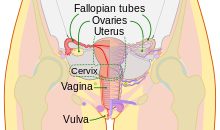


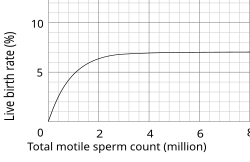

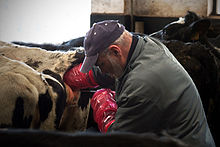
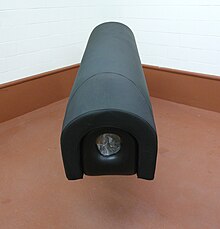

No comments:
Post a Comment